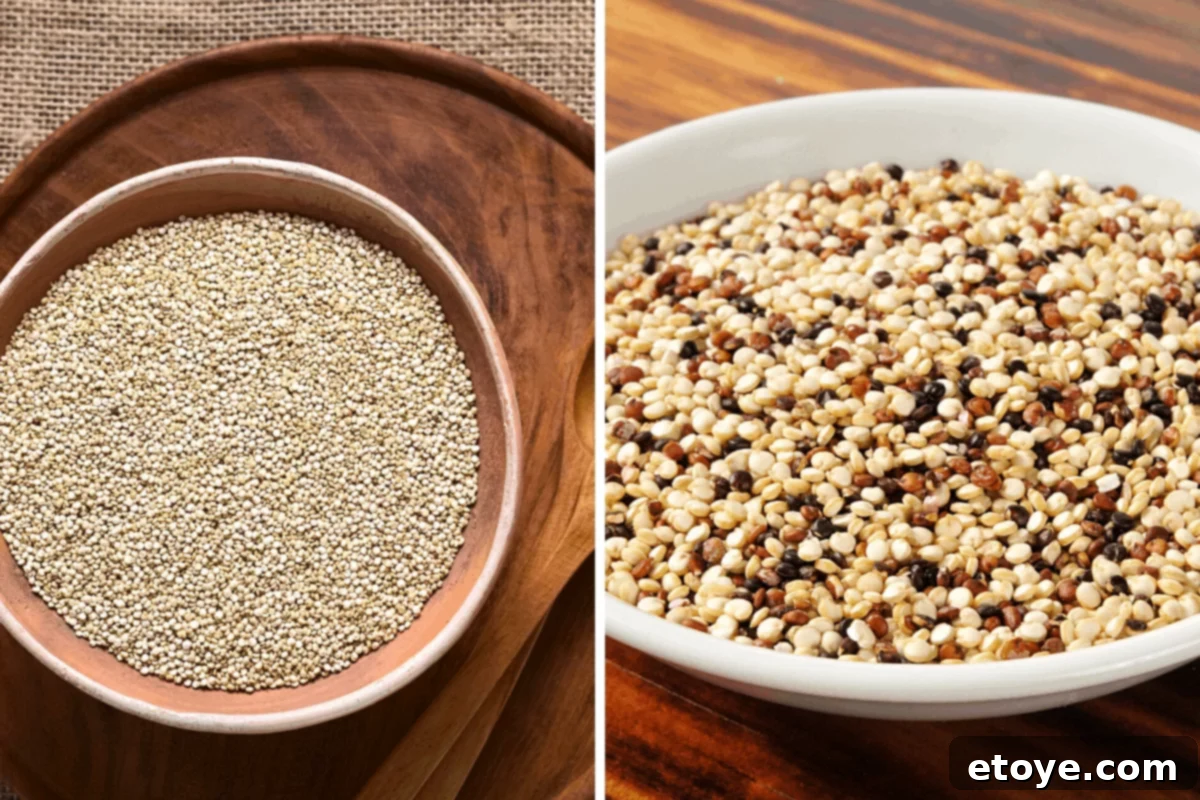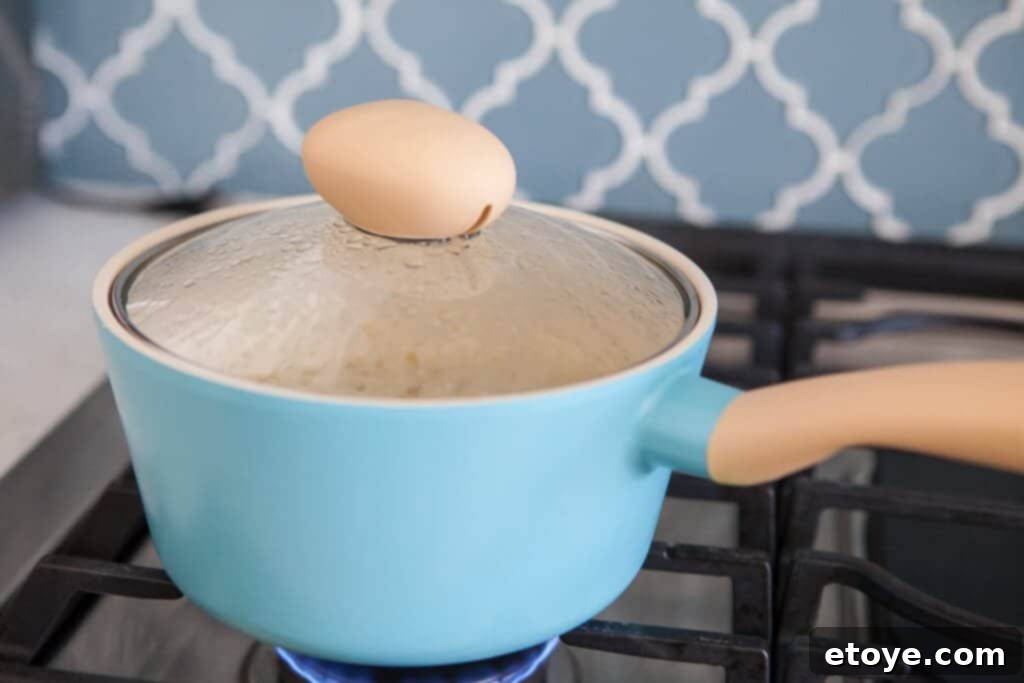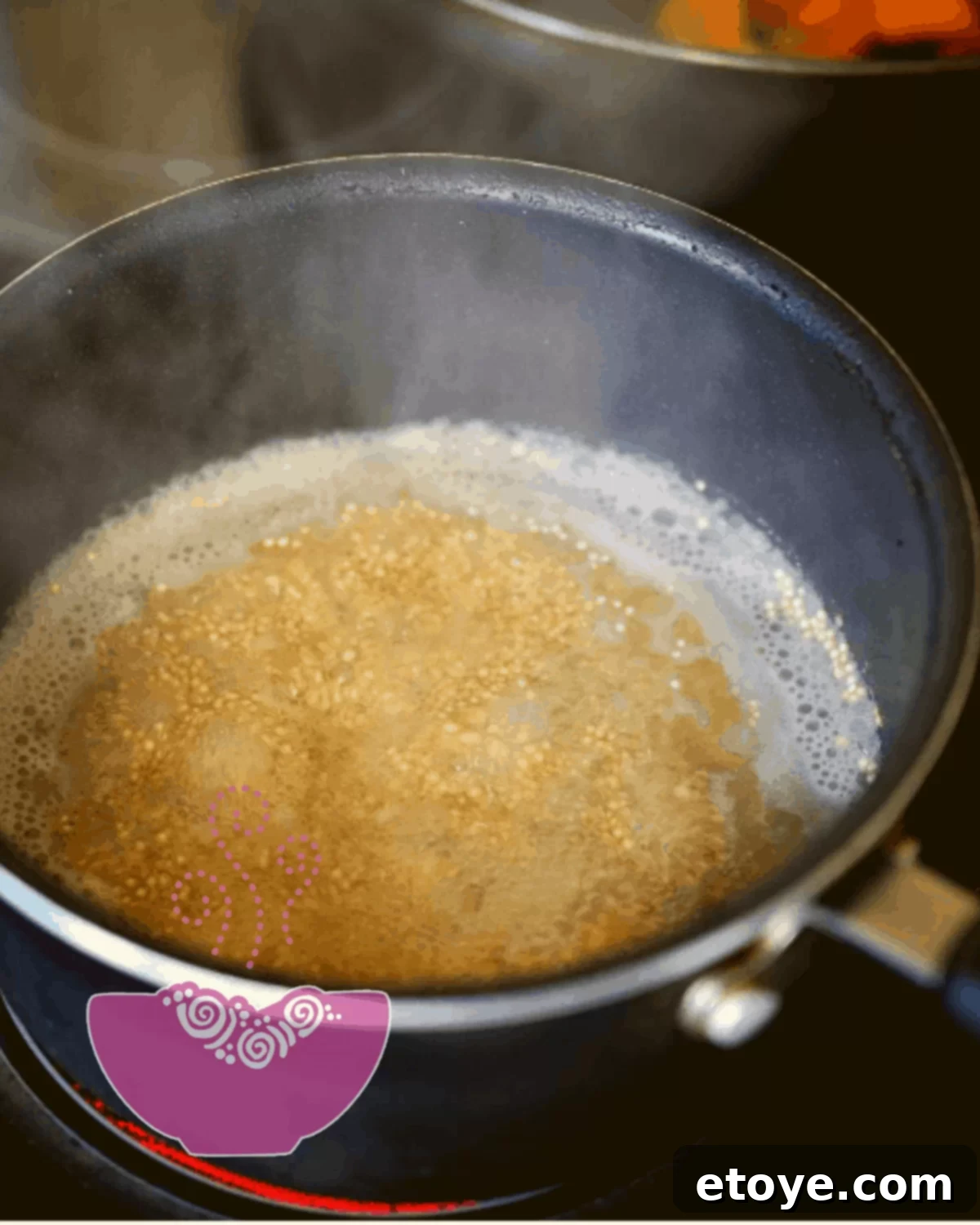How to Cook Quinoa on the Stovetop: Your Guide to Fluffy, Nutrient-Dense Perfection
Unlock the secrets to perfectly cooked quinoa right on your stovetop! This comprehensive guide will equip you with all the knowledge to prepare this versatile pseudograin, making it a staple in your healthy eating routine. Naturally gluten-free and packed with essential nutrients, quinoa stands out among grains, offering a fantastic foundation for countless delicious meals.

At Steamy Kitchen, we believe in building wholesome, satisfying one-bowl meals that nourish your body and delight your taste buds. Our philosophy centers around a sturdy base of nutrient-rich grains and fresh, vibrant greens. Imagine fluffy brown rice, delicate couscous, hearty farro, or the star of today’s show – perfectly cooked quinoa – paired with crisp salad greens. Whether you prefer a half-and-half approach, reminiscent of your favorite poke bowl, or a grain-heavy base, the goal is to discover your go-to combinations that you can effortlessly prepare again and again. This simple yet profound approach is how truly delicious and healthy Buddha bowls come to life!
Quinoa: The Ancient Seed with Modern Appeal

You might be wondering, “Isn’t quinoa a grain? Or is it technically a seed?” You’re absolutely right to ask! Quinoa (pronounced KEEN-wah) is indeed a seed, belonging to the amaranth family. It’s often referred to as a “pseudocereal” because, while botanically a seed, its culinary uses and nutritional profile closely resemble those of true grains like rice or wheat. This distinction is particularly important for those with dietary sensitivities: quinoa is naturally gluten-free. This means individuals with celiac disease or gluten sensitivity can enjoy this versatile food without worry. It has never contained gluten, making it a safe and nutritious choice for everyone.
The Unrivaled Nutritional Power of Quinoa
Beyond its gluten-free status, quinoa is a true nutritional powerhouse. This humble seed boasts an impressive array of health benefits that make it an essential addition to any diet. Compared to most traditional grains, quinoa offers significantly more protein, dietary fiber, and a full spectrum of B vitamins. What truly sets it apart is its complete protein profile: quinoa contains all nine essential amino acids, which are crucial building blocks our bodies cannot produce on their own. Very few plant-based foods can make this claim, making quinoa an invaluable source of protein for vegetarians, vegans, and anyone looking to enhance their diet.
In addition to protein and fiber, quinoa is rich in vital minerals such as magnesium, potassium, iron, zinc, and phosphorus. It also provides antioxidants, which help protect the body from damage by free radicals. Incorporating quinoa into your meals can support digestive health, help manage blood sugar levels, contribute to heart health, and provide sustained energy throughout your day. It’s a nutrient-dense choice that supports overall well-being, proving that healthy eating can be incredibly delicious and satisfying.
And don’t even begin to think that quinoa is any less flavorful or versatile than your favorite grains like rice, bulgur, or couscous. Its subtly nutty flavor and fluffy texture make it incredibly adaptable. You’ll find yourself seamlessly integrating it into casseroles, pilafs, vibrant salads, hearty stuffed peppers, comforting stuffed squash, and a myriad of other classic and creative dishes. Once you master cooking it, the culinary possibilities are truly endless!
Choosing Your Quinoa: Varieties and Their Charms
When you head to the supermarket, you’ll typically encounter a few popular varieties of quinoa, each with its own subtle characteristics. The most common types are white (or beige), red, black, and a beautiful blend often marketed as “rainbow” or “tri-color” quinoa.

- White Quinoa: Also known as beige quinoa, this is the most common and mildest variety. It cooks up the fluffiest and has a delicate, slightly nutty flavor. It’s the quickest cooking of all varieties and tends to be the least chewy, making it incredibly versatile for almost any dish.
- Red Quinoa: This variety holds its shape better after cooking, making it an excellent choice for salads or dishes where you want the grains to remain distinct. It has a slightly chewier texture and a richer, nuttier flavor compared to white quinoa. Red quinoa also boasts a beautiful color that adds visual appeal to your meals.
- Black Quinoa: With the firmest texture and a more earthy, sweet flavor, black quinoa is a fantastic option for adding depth to dishes. Like red quinoa, it maintains its integrity well after cooking, making it ideal for robust salads or as a hearty side.
- Rainbow/Tri-Color Quinoa: This blend typically combines white, red, and black quinoa, offering a delightful mix of textures, flavors, and visual appeal. It’s a great all-rounder that brings a bit of everything to your plate.
Regardless of the color you choose, you’ll enjoy quinoa’s characteristic fragrant yet pleasantly neutral taste, allowing it to easily absorb the flavors of your seasonings and accompanying ingredients. While cooking times might vary by a minute or two between varieties, the fundamental stovetop method remains the same.
Mastering the Stovetop: Essential Tips for Fluffy Quinoa Every Time
Cooking quinoa to fluffy perfection on the stovetop is surprisingly simple, but a few key tips can elevate your results from good to exceptional. Follow these guidelines to ensure your quinoa is light, airy, and full of flavor, never mushy or bitter.
- RINSE THOROUGHLY: The Saponin Secret – This step is crucial and only takes a few seconds! Quinoa seeds naturally have a bitter, soap-like coating called saponin. While most commercially sold quinoa comes pre-rinsed, a quick rinse at home ensures you remove any lingering traces that could impart an unpleasant taste. Don’t worry, a little bit of its natural character might remain, adding to its unique flavor profile, but excessive bitterness will be washed away. Use a fine-mesh sieve to prevent the tiny seeds from escaping down the drain.
- NAIL THE WATER RATIO: The Golden Rule is 1:2 – Achieving the perfect texture hinges on the correct quinoa-to-water ratio. The easy-peasy golden rule is 1 cup of dry quinoa to 2 cups of liquid (water or broth). This ratio ensures that the quinoa absorbs just enough liquid to become tender and fluffy without becoming waterlogged or drying out too soon. Towards the end of the cooking time, keep an eye on your pot; if the liquid seems to evaporate too quickly and the quinoa is still a bit firm, don’t hesitate to add a splash or two of extra water.
- PREVENT STICKING: A Simple Trick – If your water runs too low during cooking, or if your pot isn’t quite non-stick, some quinoa might stick to the bottom. You can prevent this by adding a small amount of cooking oil (like olive oil or coconut oil) to the bottom of your pot or pan before adding the quinoa and liquid. This creates a barrier that minimizes sticking and makes cleanup much easier.
- CONSIDER YOUR LIQUID CHOICE: Water vs. Broth – While water is perfectly fine for cooking quinoa, using vegetable or chicken broth can significantly enhance its flavor, adding an extra layer of savory deliciousness. Choose your liquid based on the dish you’ll be using the quinoa in. For sweeter applications or if you want a neutral base, stick with water. For savory meals, broth is an excellent upgrade.
How to Cook Quinoa on the Stovetop – Step by Step to Perfection
With just a few basic ingredients and simple steps, you’ll have perfectly cooked, fluffy quinoa ready to elevate any meal. For every 1 cup of dry quinoa, you’ll need 2 cups of water or broth, and about 1/4 teaspoon of salt. That’s it for the basics! You can always add fats, herbs, and other seasonings during or after cooking, depending on how you plan to use your delicious quinoa.

- Rinse the Quinoa Thoroughly: Place your desired amount of quinoa (e.g., 1 cup) in the finest mesh sieve you can find. A French press can also work in a pinch if you don’t have a fine sieve. The tiny individual seeds are known for their escaping tendencies! Rinse the quinoa under cool, running water until the water runs completely clear. This crucial step removes any residual saponin, ensuring a pleasant, non-bitter taste.
- Combine and Bring to a Boil: Transfer the rinsed quinoa to a medium-sized pot or deep saucepan. Add 2 cups of water or broth (for 1 cup of quinoa) and 1/4 teaspoon of salt. Bring the mixture to a rolling boil over medium-high heat.
- Simmer Until Absorbed: Once boiling, reduce the heat to low, ensuring a gentle simmer. Let the quinoa cook, *uncovered*, until all the liquid has been absorbed and small white rings (the germ of the seed separating) form around each grain. This usually takes about 15 minutes. During this stage, avoid stirring too much, as this can make the quinoa mushy. If you notice the pot drying out completely but the quinoa is still firm, add another splash or two of water.
- Rest and Fluff: Once the liquid is absorbed, immediately cover the pot with a tight-fitting lid and remove it from the heat. Let it stand undisturbed for about 5 minutes. This resting period allows the quinoa to steam in its own residual heat, making it incredibly fluffy and ensuring even cooking. After resting, remove the lid and gently fluff the quinoa with a fork before serving. This separates the grains and gives it that light, airy texture.

Now that you’ve mastered the art of cooking quinoa, you have a versatile and healthy base for an endless array of dishes. What will you create next?
Beyond the Pot: Creative Ways to Enjoy Quinoa
With a batch of freshly cooked, fluffy quinoa, your culinary options expand dramatically. Quinoa’s mild flavor and delightful texture make it an incredible canvas for both savory and sweet creations. It’s not just for healthy bowls; it can transform your breakfast, lunch, and dinner! Here are some fantastic ideas to incorporate quinoa into your diet, whether you’re using a fresh batch or repurposing leftovers:
- Sturdy Foundation for Buddha Bowls: This is where quinoa truly shines. Build vibrant and nutrient-packed bowls by combining quinoa with roasted vegetables, crispy tofu or grilled chicken, a variety of leafy greens, and a drizzle of your favorite sauce. Try a Crispy Tofu Buddha Bowl with Tangy Ponzu Sauce or a Roasted Tofu Buddha Bowl with Pineapple Teriyaki Sauce for inspiration.
- Healthy Twist on Fried Rice: Replace traditional white rice with quinoa for a protein-rich and fiber-packed Quinoa Fried Rice. It’s a fantastic way to use up leftover quinoa and vegetables.
- Savory Quinoa Patties: Mix cooked quinoa with herbs, spices, finely chopped vegetables, and an egg (or flax egg for vegan) to form delicious patties. Pan-fry or bake them for a healthy burger alternative or a side dish. These Little Quinoa Patties from Epicurious are a great starting point.
- Refreshing Salads: Quinoa salads are incredibly versatile and perfect for meal prepping. Combine chilled quinoa with chopped cucumbers, tomatoes, bell peppers, fresh herbs like parsley and mint, and a lemon-herb vinaigrette for a bright and light dish. This Vegetable Bounty Quinoa Salad with Asian Vinaigrette from Bob’s Red Mill is a must-try.
- Hearty Breakfast Bowls: Start your day with a warm and nourishing quinoa bowl. Cook quinoa with milk (dairy or non-dairy), top with fresh fruits, nuts, seeds, and a drizzle of maple syrup or honey for a satisfying breakfast that keeps you full.
- Stuffed Vegetables: Use quinoa as a filling for stuffed bell peppers, zucchini boats, or even baked apples for a savory-sweet dish. Mix it with ground meat or beans, vegetables, and cheese before baking.
- Soups and Stews: Add cooked quinoa to your favorite soups and stews during the last few minutes of cooking to boost their nutritional content and add a pleasant texture.
The possibilities are truly endless, making quinoa an indispensable ingredient in any healthy kitchen. Don’t be afraid to experiment and discover your own favorite quinoa creations!
Storing Quinoa for Freshness and Convenience
Proper storage ensures your quinoa stays fresh and ready for your next culinary adventure, whether it’s uncooked or a batch you’ve just prepared.
- Uncooked Quinoa: Store dry, uncooked quinoa in an airtight container in a cool, dark pantry. It can last for several months up to a year. For longer storage (over a year), consider keeping it in the refrigerator or freezer.
- Cooked Quinoa: Once cooked, allow the quinoa to cool completely before transferring it to an airtight container. Store it in the refrigerator for up to 3-5 days. Cooked quinoa also freezes exceptionally well. Spread it in a single layer on a baking sheet, freeze until solid, then transfer the frozen grains to a freezer-safe bag or container. It can be stored in the freezer for up to 2 months. Thaw overnight in the refrigerator or reheat directly from frozen, adding a splash of water if needed.
Troubleshooting Common Quinoa Issues
Even with simple instructions, sometimes things don’t go exactly as planned. Here are some solutions to common quinoa cooking problems:
- Mushy Quinoa: This usually happens if you’ve used too much water or cooked it for too long. Ensure you stick to the 1:2 quinoa-to-liquid ratio. If it’s already mushy, try spreading it on a baking sheet and baking at a low temperature (around 250°F / 120°C) for 10-15 minutes to dry it out slightly.
- Crunchy Quinoa: If your quinoa is still crunchy, it means it hasn’t absorbed enough liquid or hasn’t cooked long enough. Add another splash of water or broth (about 1/4 cup per cup of quinoa), cover the pot, and let it simmer for an additional 5-10 minutes on very low heat, or rest covered for longer off the heat.
- Bitter Quinoa: This is almost always due to insufficient rinsing. Always rinse your quinoa thoroughly under cold running water until the water is clear before cooking. If you forgot, adding a flavorful broth or strong spices during cooking might help mask the bitterness, but prevention is key.
The Art of the Buddha Bowl: A Perfect Match for Quinoa
The concept of a “Buddha bowl” has gained immense popularity for a reason: it’s a delicious, balanced, and aesthetically pleasing way to eat healthy. At its core, a Buddha bowl is a simple meal that consists of small portions of several different foods, typically plant-based, served in a single bowl. The idea is to combine a variety of textures, colors, and flavors to create a harmonious and nourishing dish. Quinoa is often the star ingredient, providing a rich, whole-food base that anchors the entire meal.
A typical Buddha bowl often includes:
- A Grain Base: Like quinoa, brown rice, or farro, providing complex carbohydrates and fiber.
- Protein: Such as roasted chickpeas, lentils, tofu, tempeh, or grilled chicken/fish.
- Vegetables: A mix of raw, roasted, or steamed vegetables for vitamins, minerals, and crunch. Think broccoli, sweet potatoes, kale, carrots, or bell peppers.
- Healthy Fats: Avocado, nuts, seeds, or a drizzle of olive oil.
- A Flavorful Dressing: Tahini-based, peanut, or citrus vinaigrettes are common, tying all the ingredients together.
Quinoa’s ability to absorb flavors and its complete protein content make it an ideal choice for the foundation of any Buddha bowl. It not only provides essential nutrients but also contributes to the satisfying fullness that makes these bowls so beloved. Experiment with different combinations of fresh and cooked ingredients to discover your perfect Buddha bowl.
For more detailed information on quinoa’s incredible nutrition and health benefits, click here.
You might also like: How To Cook Ancient Grains, where you can explore other healthy alternatives.
See our whole collection of Buddha Bowl grains for more inspiration and recipes!
Loved this recipe? Stop by the comments and let us know your thoughts and favorite quinoa tips!

How to Cook Quinoa on the Stovetop Recipe
Ingredients
- 1 cup quinoa white or tri-color/rainbow
- 2 cups water or broth
- ¼ teaspoon salt
Instructions
- Rinse quinoa under cool water until water runs clear.
- Combine quinoa, salt, and 2 cups water or broth in a pot or deep saucepan and bring to a boil. Reduce heat to low and let simmer, uncovered, until water is absorbed and white rings form around each grain, about 15 minutes. Add a small splash of water towards the end if quinoa becomes too dry.
- Cover pot, remove from heat, and let stand for about 5 minutes before fluffing with a fork.
